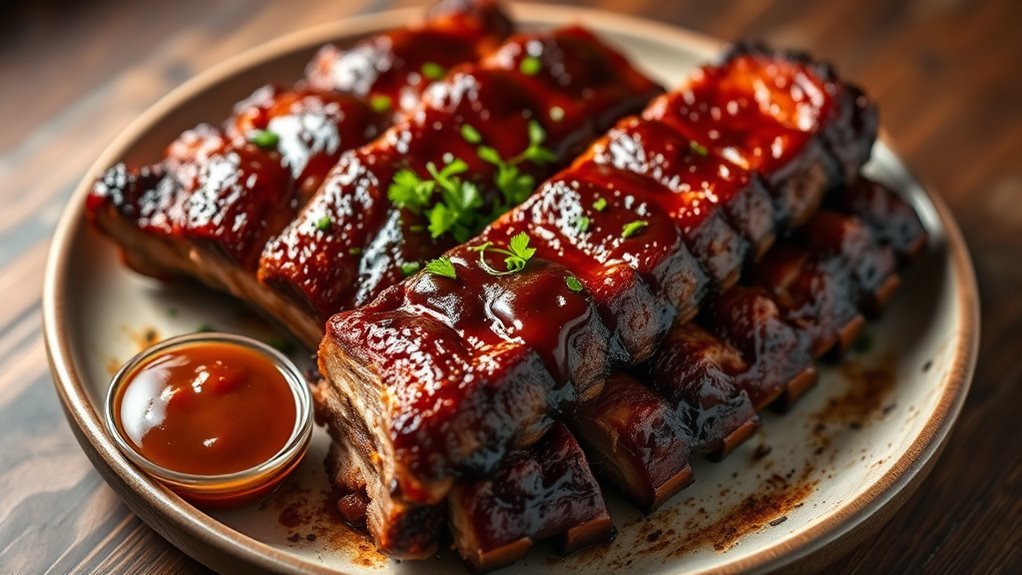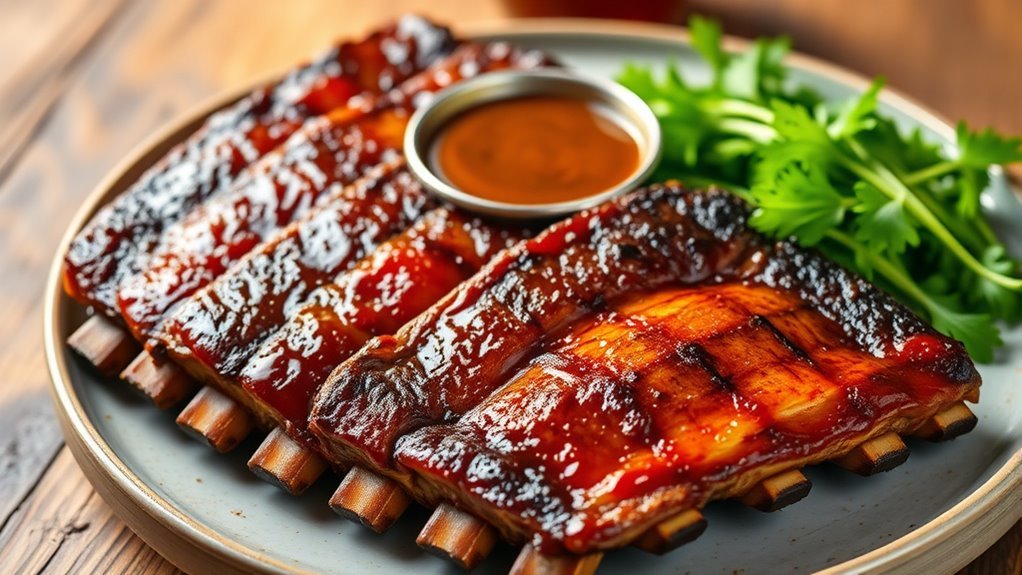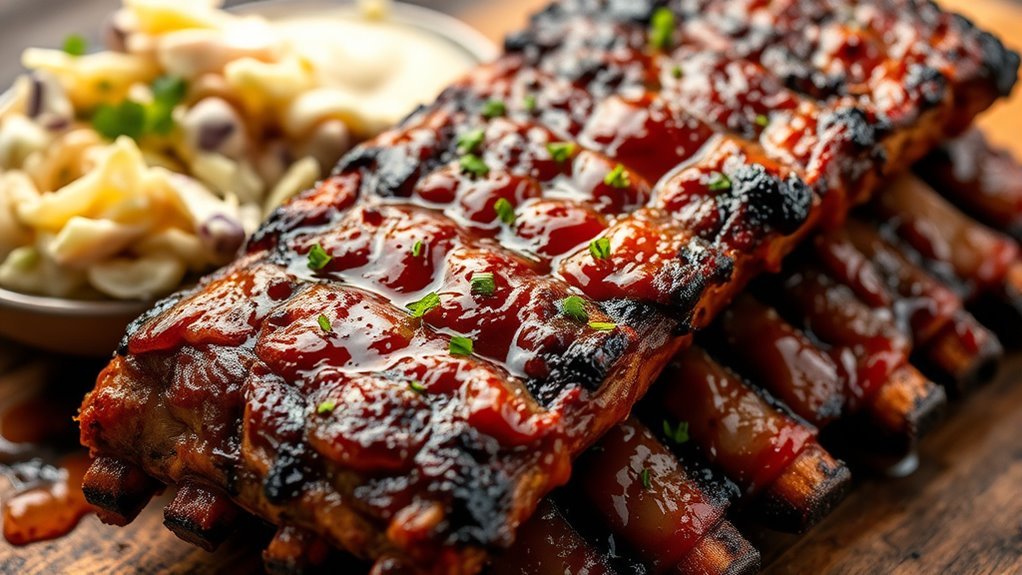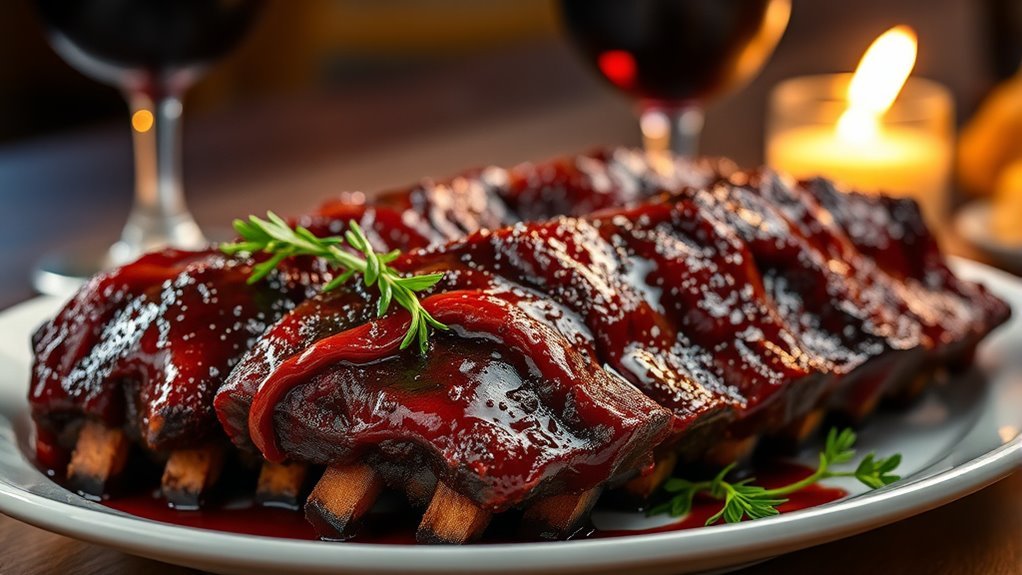Yes, ribs can be keto-friendly! They’re high in fat, providing around 23g per 100g, and rich in protein, with about 20g per 100g. This makes them suitable for maintaining ketosis when you keep your carbohydrate intake low. Just be cautious with sauces and marinades, as many contain added sugars. Instead, opt for homemade or low-carb options. If you’re curious about how to prepare them perfectly or enjoy them out, there’s more to explore.
Understanding the Keto Diet Basics

When you begin a keto diet, it’s essential to understand its core principles to achieve the best results. The keto diet fundamentals revolve around drastically reducing carbohydrate intake while increasing fats to enter a state of ketosis. This metabolic state encourages your body to burn fat for fuel instead of carbohydrates. To achieve this, you’ll need to focus on specific macronutrient ratios: typically around 70-75% fats, 20-25% protein, and only 5-10% carbohydrates. Keeping these ratios in mind helps you select foods that support your goals. By adhering to these guidelines, you can enjoy the freedom of eating delicious meals while optimizing your energy levels and weight loss potential. Understanding these basics sets the foundation for your keto journey.
Nutritional Profile of Ribs

Ribs are not just a delicious barbecue favorite; they also offer a compelling nutritional profile that can fit well within a keto diet. You’ll find that rib nutrition is rich in protein content and healthy fats, providing a satisfying meal option. Here’s a quick overview of the key nutritional aspects:
| Nutrient | Amount per 100g | Benefits |
|---|---|---|
| Protein | 20g | Muscle repair, satiety |
| Fat | 23g | Energy source, flavor |
| Calories | 300 | Energy provision |
| Micronutrients | Varies | Collagen benefits, vitamins |
With their high fat levels and calorie count, ribs can help you stay in ketosis, while the collagen benefits support joint health. Enjoy ribs with confidence on your keto journey!
Types of Ribs: A Breakdown

Understanding the different types of ribs can enhance your culinary experience, especially when you’re following a keto diet. There are two main categories: beef ribs and pork ribs. Within pork ribs, you’ll find baby back ribs, known for their tenderness, and spare ribs, which are larger and meatier. St. Louis ribs are a trimmed version of spare ribs, offering a uniform shape ideal for cooking. Rib tips are the smaller, flavorful ends of spare ribs. When preparing these cuts, many opt for dry rubs to enhance the flavor without adding carbs. Smoked ribs are a popular choice, as the smoking process adds depth without compromising your keto goals. Each type offers unique flavors, making them perfect for any barbecue enthusiast.
Cooking Methods for Ribs
When it comes to cooking ribs, the method you choose can greatly impact flavor and tenderness. You might consider grilling for a smoky finish, slow cooking for melt-in-your-mouth meat, or baking for a crispy exterior. Each technique has its unique advantages, and knowing how to use them can elevate your rib dishes while keeping them keto-friendly.
Grilling Techniques for Ribs
Grilling ribs can elevate your outdoor cooking game, especially when you use the right techniques to enhance flavor and tenderness. Start by selecting your marinade options; a blend of vinegar, spices, and a touch of sweetness can create a delicious base. Let the ribs soak for a few hours to absorb those flavors. When it’s time to grill, aim for medium heat—around 225°F to 250°F is ideal. This low-and-slow approach guarantees the ribs cook evenly and become tender. Flip them occasionally, and consider using a drip pan to catch excess fat. Finally, apply your favorite BBQ sauce during the last few minutes to prevent burning. Enjoying perfectly grilled ribs can be a satisfying, keto-friendly treat!
Slow Cooking Methods
If you’re looking to achieve tender, fall-off-the-bone ribs, slow cooking is an excellent method that can deliver outstanding results. Using a slow cooker for barbecue ribs allows the meat to cook gradually, breaking down connective tissues and infusing flavors from your chosen marinades or rubs. The low, steady heat helps maintain moisture, resulting in juicy, flavorful ribs. Typically, you’ll want to cook them on low for about 6-8 hours, depending on the thickness and type of ribs. To enhance the barbecue flavor, consider adding your favorite sauce in the last hour of cooking. This method not only simplifies your cooking process but also frees you up to enjoy other activities while the ribs transform into a delicious meal.
Baking Ribs Perfectly
While many might think of grilling as the go-to method for cooking ribs, baking them can yield equally impressive results with less fuss. Start by preheating your oven to 300°F (150°C). Use baking techniques like wrapping the ribs in foil to retain moisture and enhance tenderness. A good rib marinade is essential; consider a blend of olive oil, garlic, and your favorite spices. Allow the ribs to marinate for at least an hour, or overnight for deeper flavor. Place the wrapped ribs on a baking sheet and cook for about 2.5 to 3 hours. Unwrap them in the last 30 minutes to caramelize the surface. This method guarantees juicy, flavorful ribs that are keto-friendly and satisfyingly delicious.
Sauces and Seasonings: What to Avoid
When you’re diving into the world of keto-friendly ribs, it’s important to be mindful of the sauces and seasonings you choose, as many can quickly derail your diet. Watch out for barbecue sauces—they often pack high sugar content and hidden carbs that can sabotage your carb count. Even seemingly innocent marinades may contain flavor enhancers that contribute unnecessary carbs. Always check ingredient labels for high-fructose corn syrup and other sweeteners that add calories without nutritional benefit. Instead, opt for homemade sauces using keto-approved ingredients like mustard, garlic, and spices. By being vigilant about what you add to your ribs, you can enjoy delicious flavors while staying true to your keto goals. Choose wisely, and savor the freedom of your diet!
Sides That Pair Well With Ribs
When enjoying ribs, choosing the right sides can enhance your meal while keeping it keto-friendly. Low-carb vegetable options like sautéed spinach or roasted cauliflower are nutritious and satisfying. Additionally, creamy side dishes and keto-friendly sauces can complement the flavors of the ribs without derailing your dietary goals.
Low-Carb Vegetable Options
If you’re enjoying a plate of savory ribs and looking for low-carb vegetable sides to complement your meal, you’re in luck. Cauliflower rice is a fantastic option, providing a rice-like texture without the carbs. Zucchini noodles add a revitalizing twist and can be sautéed or served raw. For crunch, consider broccoli slaw or bell pepper strips, both rich in vitamins and low in calories. A spinach salad drizzled with olive oil pairs beautifully with the rich flavors of ribs. Asparagus spears, roasted or grilled, offer a satisfying bite. For a hearty side, mushroom stir fry brings umami goodness, while cabbage wraps serve as a versatile, low-carb alternative to traditional bread. Enjoy your meal with these delightful options!
Keto-Friendly Sauces
While enjoying your ribs, incorporating keto-friendly sauces can elevate your meal without compromising your low-carb goals. Look for sauces made with sugar substitutes like erythritol or stevia, which provide sweetness without the carbs. Low carb marinades are another great option, often featuring ingredients like olive oil, vinegar, and spices that enhance flavor without adding unnecessary sugars. For a zesty kick, consider mustard-based sauces or spicy blends that keep the carb count low. When shopping, always check ingredient lists to verify there are no hidden sugars. With the right sauces, you can enjoy flavorful ribs while sticking to your keto lifestyle, making your dining experience both satisfying and guilt-free.
Creamy Side Dishes
To complement your delicious ribs, creamy side dishes can make your meal even more satisfying. Consider creamy cauliflower—rich and buttery, it’s a fantastic low-carb alternative to mashed potatoes. Cheesy broccoli, drizzled with garlic butter, adds both flavor and a touch of indulgence, making it a perfect companion. For a crowd-pleaser, spinach dip brings a creamy texture and vibrant flavor that pairs beautifully with ribs. If you’re in the mood for something savory, a rich mushroom sauce can elevate your ribs and provide a comforting, earthy element. These creamy sides not only enhance the overall meal experience but also align well with a keto lifestyle, allowing you to enjoy freedom in your dining choices.
Portion Control and Serving Sizes
Understanding portion control and serving sizes is essential when incorporating ribs into a keto-friendly diet, especially since they can be calorie-dense and high in fat. To enjoy ribs without derailing your diet, consider these serving suggestions:
| Portion Size | Calories | Protein (g) |
|---|---|---|
| 3 oz | 300 | 25 |
| 4 oz | 400 | 30 |
| 6 oz | 600 | 45 |
| 8 oz | 800 | 60 |
Keeping your portion sizes in check guarantees you stay within your daily macro requirements. Enjoying ribs in moderation lets you savor the flavors while maintaining your keto goals. Remember to balance your plate with low-carb sides for a complete meal!
How to Make Ribs Keto-Friendly
Making ribs keto-friendly requires a few strategic adjustments, especially regarding seasoning and cooking methods. To keep your ribs low in carbs while maximizing flavor, consider these tips:
- Choose low-carb ribs marinades: Opt for vinegar-based or mustard-based marinades instead of sugary sauces.
- Create your own rib rubs: Use spices like paprika, garlic powder, and cayenne without added sugar to enhance flavor.
- Avoid traditional BBQ sauces: Most store-bought sauces are high in sugar; instead, make a homemade version using keto-friendly ingredients.
- Cook with care: Slow-cook or smoke your ribs for tenderness without the need for carb-laden sauces.
With these adjustments, you can enjoy delicious, keto-friendly ribs that fit seamlessly into your lifestyle!
Popular Keto Rib Recipes
After mastering how to make ribs keto-friendly, you might be enthusiastic to explore some popular recipes that showcase this delicious dish while keeping it low in carbs. One great option is to use keto rib marinades, like a blend of olive oil, apple cider vinegar, garlic, and your favorite herbs. This not only infuses flavor but also maintains the dish’s keto integrity.
For seasoning, consider rib seasoning blends that emphasize spices like paprika, cumin, and black pepper without adding sugar. Another favorite is smoked ribs, where you can apply a dry rub before cooking to enhance the smoky flavor. Pair these ribs with a fresh keto-friendly side salad, and you’ve got a meal that’s satisfying and compliant with your dietary goals.
Tips for Eating Out on a Keto Diet
When you’re dining out on a keto diet, it’s essential to know how to navigate menus effectively to stick to your low-carb goals. Here are some tips to enhance your restaurant choices and apply menu hacks:
- Look for protein-rich options: Choose dishes centered around meat, fish, or eggs.
- Substitute sides: Replace starchy sides with low-carb alternatives like salads or steamed vegetables.
- Dressings and sauces: Opt for oil-based dressings or ask for sauces on the side to control carb intake.
- Don’t hesitate to customize: Most restaurants accommodate dietary needs, so feel free to request modifications.
Frequently Asked Questions
Can I Eat Ribs on a Strict Ketogenic Diet?
Did you know that ribs can contain around 20 grams of protein per serving? If you’re on a strict ketogenic diet, you can absolutely enjoy ribs, especially when prepared without sugary sauces. Opt for dry rubs to keep them low-carb. Pair them with keto-friendly sides like cauliflower mash or grilled vegetables for a satisfying meal. Just be mindful of portion sizes, as excess carbs can sneak in with certain preparations. Enjoy your freedom to indulge!
Are Baby Back Ribs Better Than Spare Ribs for Keto?
When comparing baby back ribs vs spare ribs for your keto journey, baby back ribs are generally leaner, containing less fat and fewer calories. They’re often more tender, making them easier to cook. If you prefer grilling or smoking, both methods work well for either type, but baby backs may require less cooking time. Ultimately, it comes down to personal preference, but baby backs can be a lighter choice for your low-carb meals.
Do Ribs Contain Hidden Sugars?
When considering whether ribs contain hidden sugars, it’s essential to look at the marinade used. Many marinades include ingredients like barbecue sauce, which can have high sugar content. If you’re watching your sugar intake, you should check the labels or opt for sugar-free marinades. Grilling or smoking ribs without sugary sauces can keep their sugar content low, allowing you to enjoy them without the worry of unexpected carbs in your diet.
How Do I Know if Ribs Are Processed?
When it comes to ribs, you’d think they’re as simple as a summer barbecue, but you must explore deeper. To identify if ribs are processed, check the meat labeling. Look for terms like “smoked,” “cured,” or “pre-seasoned,” which often signal additives or preservatives. Fresh ribs usually have minimal ingredients, while processed ones might contain hidden sugars or fillers. Understanding ribs preparation can truly set you free in making healthier choices!
Can I Eat Ribs Daily on Keto?
Eating ribs daily on a keto diet can be enjoyable, but moderation is key. While ribs are high in protein and healthy fats—beneficial for keto—frequent consumption might lead to nutrient imbalances. The keto diet’s benefits include weight loss and improved energy, but too much saturated fat and sodium from daily rib consumption could counteract these gains. Balance your meals with low-carb veggies to guarantee you’re getting a well-rounded diet while enjoying those ribs!


